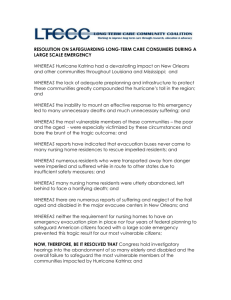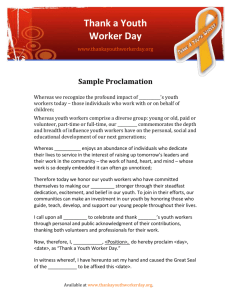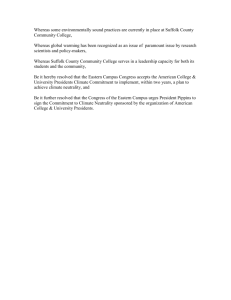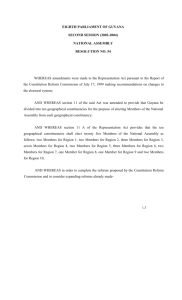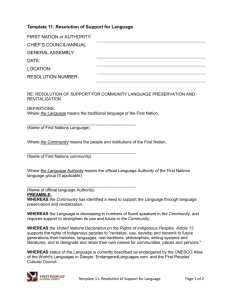Resolutions Adopted by GANS- 2013
advertisement
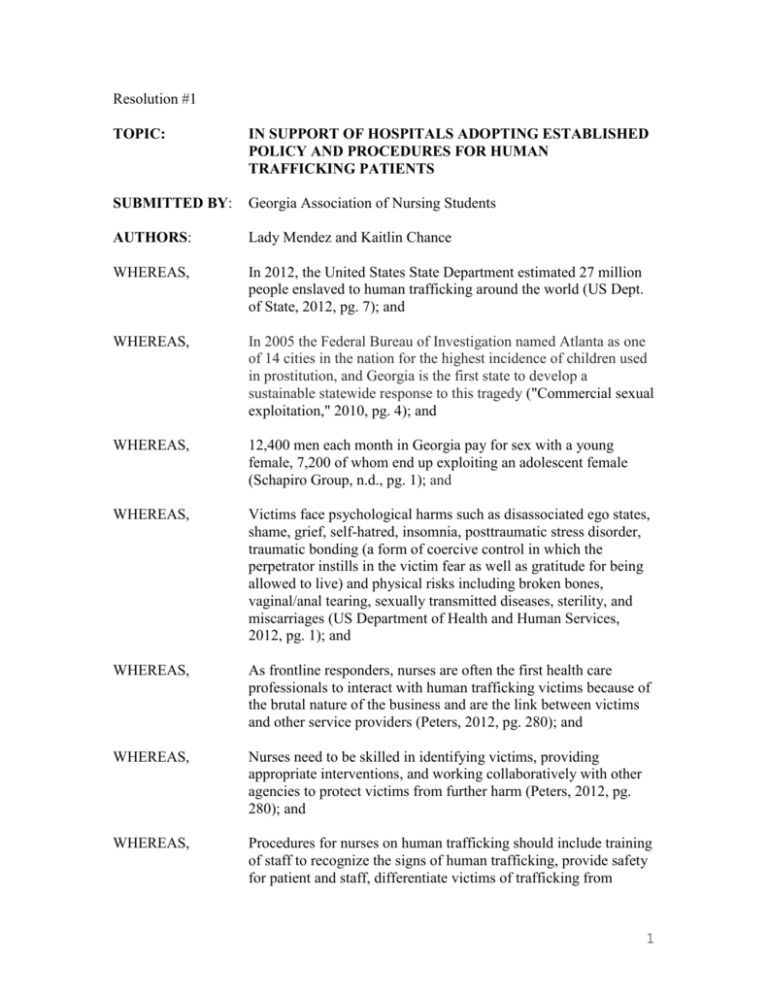
Resolution #1 TOPIC: IN SUPPORT OF HOSPITALS ADOPTING ESTABLISHED POLICY AND PROCEDURES FOR HUMAN TRAFFICKING PATIENTS SUBMITTED BY: Georgia Association of Nursing Students AUTHORS: Lady Mendez and Kaitlin Chance WHEREAS, In 2012, the United States State Department estimated 27 million people enslaved to human trafficking around the world (US Dept. of State, 2012, pg. 7); and WHEREAS, In 2005 the Federal Bureau of Investigation named Atlanta as one of 14 cities in the nation for the highest incidence of children used in prostitution, and Georgia is the first state to develop a sustainable statewide response to this tragedy ("Commercial sexual exploitation," 2010, pg. 4); and WHEREAS, 12,400 men each month in Georgia pay for sex with a young female, 7,200 of whom end up exploiting an adolescent female (Schapiro Group, n.d., pg. 1); and WHEREAS, Victims face psychological harms such as disassociated ego states, shame, grief, self-hatred, insomnia, posttraumatic stress disorder, traumatic bonding (a form of coercive control in which the perpetrator instills in the victim fear as well as gratitude for being allowed to live) and physical risks including broken bones, vaginal/anal tearing, sexually transmitted diseases, sterility, and miscarriages (US Department of Health and Human Services, 2012, pg. 1); and WHEREAS, As frontline responders, nurses are often the first health care professionals to interact with human trafficking victims because of the brutal nature of the business and are the link between victims and other service providers (Peters, 2012, pg. 280); and WHEREAS, Nurses need to be skilled in identifying victims, providing appropriate interventions, and working collaboratively with other agencies to protect victims from further harm (Peters, 2012, pg. 280); and WHEREAS, Procedures for nurses on human trafficking should include training of staff to recognize the signs of human trafficking, provide safety for patient and staff, differentiate victims of trafficking from 1 patients who have experienced other forms of child abuse or intimate partner violence, referring for follow-up and reporting to authorities (de Chesnay, 2012, pg. 302); and WHEREAS, Nurses can play a role in identifying, intervening, and advocating for victims of human trafficking as they currently do for patients that are the victims of other types of violent crimes (McCain, 2011, pg. 251); therefore be it RESOLVED, that the Georgia Association of Nursing Student (GANS) encourage health care providers, hospitals, and emergency departments to adopt established policy and procedures on human trafficking; and be it further RESOLVED, GANS supports education on human trafficking by hosting sessions at the annual convention, encouraging nursing curriculum education on human trafficking policy and procedures, by dispersing information through publishing and EKG article, fact sheet, and resources on how to identify and educate at-risk youth; and be it further RESOLVED, GANS encourages constituents to advocate for the vulnerable population, at risk youth and those currently in the human trafficking life by attending task force meetings and developing projects to raise awareness and support for organizations currently in place to end human trafficking in the state of Georgia; and be it further RESOLVED, that the NSNA send a copy of this resolution to: the American Nurses Association, the National League of Nursing, the American Association of Colleges of Nursing, the National Organization for Associate Degree Nursing, the American Medical Association, the American Academy of Nursing, the Emergency Nurses Association, National Association of Pediatric Nurse Associates and Practitioners, the Society of Pediatric Nurses, the Georgia Nurses Association, and all others deemed appropriate by the NSNA Board of Directors. 2 Resolution # 2 TOPIC: IN SUPPORT OF GANS DESIGNATION OF THE FIRST WEEK IN JANUARY 2014 AS AMERICAN RED CROSS AWARENESS WEEK TO PROMOTE GEORGIA NURSING STUDENTS' AWARENESS OF AND PARTICIPATION IN THE MISSION OF THE AMERICAN RED CROSS SUBMITTED BY: Brenau Association of Nursing Students AUTHORS: Tara Davis, Abigail Rodriguez, and Charnella Rosas WHEREAS, "The American Red Cross (ARC) was granted the sole U.S. federal government charter in 1900 and again in 1905 to: fulfill the provisions of the Geneva Convention, provide family communications and other support to the U.S. military, and to maintain a system of domestic and international disaster relief, including its responsibilities with FEMA" (American Red Cross. (2013).); and WHEREAS, An average of more than 9 million people annually are trained in First Aid, AED and CPR through American Red Cross training classes (American Red Cross. (2013).).; and WHEREAS, In order to provide the 30 million transfused blood components used each year in the U.S., over 44,000 blood donations are required per day (American Red Cross. (2006).); and WHEREAS, Each pint of donated blood may be made into three lifesaving blood products (PRBC, plasma, and platelets), and the blood used in any emergency or transplant situation must be "on the shelves" prior to the emergency occurring (American National Red Cross. (2011).) A transplant may take up to 100 donated units of blood with the average red blood cell transfusion being three pints (American National Red Cross. (2011).) ; and WHEREAS, The American Red Cross receives 80% of all donations through community blood drives, making the ARC the single largest blood supplier in the United States (American National Red Cross. (2011).).; and WHEREAS, GANS stated mission "to…promote the development of skills that students will need as responsible and accountable members of the nursing profession" (Georgia Association of Nursing Students. (2013).).; and it therefore be 3 RESOLVED, That GANS will promote and foster knowledge of the ARC's three-part mission and its significance to nursing students; and be it further RESOLVED, To designate the first week in January 2014 as ARC Awareness Week, challenging GANS members to donate blood in their local communities to replenish the holiday shortage and encouraging GANS members to educate their family and friends about the American Red Cross; and be it further RESOLVED, That the Publications Director will update the GANS website and our social media presence prior to January 1, 2014 with current Red Cross information, contacts, and volunteer information as provided by the Community Director of GANS. 4 Resolution # 3 TOPIC: IN SUPPORT OF INCREASED AWARENESS OF RECOMMENDATIONS ON THE USE OF QUADRIVALENT HUMAN PAPILLOMAVIRUS (HPV) VACCINATION FOR MALES SUBMITTED BY: Emory Student Nurses Association AUTHOR: Lauren Franke WHEREAS, the Centers for Disease Control and Prevention (CDC) reports that “genital human papillomavirus (HPV0 is the most common sexually transmitted infection, with approximately 70 million Americans currently infected and about 14 million people becoming newly infected each year” (Genital HPV Infection-Fact Sheet, Centers For Disease Control and Prevention [CDC], 2013); and WHEREAS, though more than 130 HPV genotypes exist, the HPV4 vaccine is directed against HPV types 6, 11, 16, and 18, with an annual estimated 7,000 cancers (anal, penile, and oropharyngeal) in males associated with types 16 and 18, and approximately 250,000 cases of genital warts in males cause by types 6 and 11 (Thomas & Snell, 2013; Recommendations on the Use of Quadrivalent Human Papillomavirus Vaccine in M-Advisory Committee on Immunization Practices (ACIP), 2011); and WHEREAS, in 2011, the Advisory Committee on Immunization Practices (ACIP) recommended use of quadrivalent human papillomavirus vaccine for 1) boys ages 11 or 12 years; 2) males ages 13 through 21 years, who have not initiated or completed the 3-dose series; 3) men who have sex with men, as well as for immunocompromised males; and 4) men aged 22 through 26 years who wish to receive the vaccine (HPV Vaccine Now Recommended for Boys and Young Men, Medscape, 2012); and WHEREAS, despite these recommendations, in 2012, only 6.8% of boys aged 13-17 years received all three recommended doses of HPV vaccine (2012 National Immunization Survey (NIS)-Teen, Centers of Disease Control and Prevention [CDC], 2012); and WHEREAS, a 2011 study in the New England Journal of Medicine concluded that “the prophylactic administration of quadrivalent HPV is efficacious in preventing the development of external genital lesions association with infection with HPV- 6, 11,16, or 18 in boys and men 16 to 26 years of age” (Guiliano, et al.,2011); and 5 WHEREAS, “since 2006, about 57 million doses of HPV vaccine have been distributed in the U.S., and in the years of HPV vaccine safety studies and monitoring, no serious safety concerns have been identified” (Tips and Time-savers for Talking with Parents about HPV Vaccine, Centers for Disease Control and Prevention, 2013); and WHEREAS, “a reduction in the incidence of HPV-related disease is likely to be associated with substantial reduction in the economic burden associated with HPV-related cancers and genital warts” (Marty, Roze, Bresse, Largeron, & Smith-Palmer, 2013, p.11); and WHEREAS, a combination of factors account for the low vaccine uptake in the U.S. including “inadequate provider recommendations, issues regarding provider reimbursement, infrequent use of reminder/recall systems that would foster completion of the threedose series, and factors such as parental hesitancy, health care access, and general challenges in vaccine delivery to adolescents” (Jemal, et al., 2013, p.196); therefore be it RESOLVED, that the Georgia Association of Nursing Students (GANS) encourage it constituents to advocate for increased parental and provider awareness of the recommendations on HPV Vaccination for males through education promotion, and be it further RESOLVED, that the GANS should publish an article on this topic in the EKG, if feasible, and be it further RESOLVED, that the GANS submit a copy of this resolution to the Georgia Nurses Association, The American Nurses Association, the National League for Nursing, the American Academy of Pediatrics, the American Association of Colleges of Nursing, the American Academy of Nurse Practitioners, the National Organization for Associate Degree Nursing, the Centers for Disease Control and Prevention, the American Medical Association, Sigma Theta Tau International, The National Student Nurses Association, the Georgia Department of Community Health, the Institute for Healthcare Improvement, and all others deemed appropriate by the GANS Board of Directors 6 Resolution # 4 TOPIC: IN SUPPORT OF INCREASED AWARENESS REGARDING DELAYED PATIENT REACTIONS TO BLOOD TRANSFUSIONS SUBMITTED BY: Kennesaw State University Student Nurses Association AUTHORS: Lauren Cedor WHEREAS, a total of 30 million blood components are transfused each year in the United States to an approximate five million patients; and WHEREAS, "transfusion-related complications can be categorized as acute which occur within minutes to 24 hours of the transfusion or delayed which may develop days, months, or even years later" (Sharma, Sharma, & Tyler, 2013); and WHEREAS, research and education on signs and symptoms which indicate an acute reaction to transfusion are numerous; and WHEREAS, one study found that 20 percent of transfusion recipients experience acute reactions to transfusions with an 11 percent mortality rate while delayed reactions to transfusions make up approximately five percent of all transfusion complications (Kumar, Thapliyal, Coshic, & Chatterjee, 2013) with a 90 percent mortality rate (Sharma et al., 2013); and WHEREAS, "delayed transfusion reactions may occur after the administration of donor red cells even though they have been shown to be compatible in cross match tests by the antiglobulin technique"(Dolatkhah et al., 2013); and WHEREAS, when polled, the majority of nurses who routinely administered blood transfusions were not aware that reactions can manifest days and weeks post transfusion indicating a gap in knowledge (Adams et al., 2013) regarding delayed reactions to transfusions, risk factors related to developing a delayed reaction, symptoms to be aware of, and nursing interventions to implement when a patient is at a high risk for or does develop a delayed reaction; and WHEREAS, risk factors that increase susceptibility for developing a delayed reaction include "Hodgkin disease, stem cell transplant, history of solid tumors treated with cytotoxic drugs, transfusion in premature infants"(Sharma et al., 2013); and 7 WHEREAS, "symptoms include rash, fever, diarrhea, liver dysfunction, and pancytopenia occurring one to six weeks after transfusion"(Sharma et al., 2013); and WHEREAS, "gamma irradiation of blood products keeps the donor lymphocytes from proliferating and can prevent transfusionassociated graft-versus-host disease" in patients who are at high risk for delayed reactions (Sharma et al., 2013); and WHEREAS, immediate treatment "in an intensive care unit and medication to modulate the immune system, including corticosteroids and high dose immunoglobulin"(Dolatkhah et al., 2013) and "automated red blood cell exchanges to replace newly-incompatible red blood cells with antigen-negative units" have been shown to be an effective treatment for delayed reactions (Tormey and Stack, 2013); therefore be it RESOLVED, that the GANS encourage its constituents to become educated regarding the possibility of delayed reactions to blood transfusions; and be it further RESOLVED, that the GANS work in collaboration with the American Red Cross to create and distribute nursing educational materials about patient risk factors that are related to a delayed transfusion reaction, symptoms of delayed transfusion reactions, and nursing interventions that can be implemented when a delayed transfusion reaction occurs; and be it further RESOLVED, that the GANS and its constituents encourage nursing colleges and universities to teach students about acute and delayed reactions to transfusions through their curriculum; and be it further RESOLVED, that the GANS publish an article on this topic in EKG, if feasible; and be it further RESOLVED, that the GANS send a copy of this resolution to the American Red Cross, the American Nurses Association, the National League for Nursing, the American Association of Colleges of Nursing, the Georgia Association of Nursing Educators, the American Association of Critical Care Nurses, the Emergency Nurses Association, and all others deemed appropriate by the GANS Board of Directors. 8 Resolution # 5 TOPIC: IN SUPPORT OF INCREASED AWARENESS OF HEALTHY PEOPLE 2020 SEXUALLY TRANSMITTED DISEASE OBJECTIVES AIMED AT REDUCING INCIDENCE RATES OF CHLAMYDIA TRACHOMATIS AND NEISSERIA GONORRHOEAE INFECTION AMONG YOUNG PEOPLE (15-24 YEARS) SUBMITTED BY: Nursing Students of Georgia State University AUTHORS: Ashley Hampton WHEREAS, according to the Centers for Disease Control and Prevention (2012), the two most common reportable infectious diseases in the Unites States are Chlamydia trachomatis (CT) and Neisseria gonorrhoeae (NG) respectively (p. 7, 19); and WHEREAS, in 2011, nationally reported cases of CT numbered 1,412,791 and reported cases of NG numbered 321,849. There were 39,829 reported cases of CT and 16,428 reported cases of NG in Georgia (CDC, 2012, Tables A3, 3, and 19); and WHEREAS, the majority of reported cases of CT (62%) and NG (70)% are documented in 15-24 year olds (CDC, 2013b, p.2); and WHEREAS, it is estimated that in the year 2000 alone, healthcare costs associated with Chlamydia and gonorrhea were a minimum of $325 million (Datta et al., 2007); and Chlamydia and gonorrhea are implicated in the etiology of “cervicitis and urethritis, as well as pelvic inflammatory disease, ectopic pregnancy, chronic pelvic pain and infertility… and can facilitate HIV infection” (Datta et al., 2007); and WHEREAS, WHEREAS, complications of Chlamydia and gonorrhea related to pelvic inflammatory disease and infertility cost up to $1.5 billion annually (Bowers, 2010, p.246); and WHEREAS, Black et al. (2011, introduction and results) report that of the 48% of sexually active high school students surveyed, “almost 40% did not use a condom during their most recent sexual intercourse”; and WHEREAS, both the Centers for Disease Control and the United States Preventive Services Task Force recommend that all sexually active women under 25 years of age are screened for CT at a minimum of 9 yearly, and NG screening for at-risk sexually active women (Chacko et al., 2010; CDC, 2013, pg.3); and WHEREAS, CT and GN are largely asymptomatic and under-diagnosed despite ongoing efforts at increasing screening efforts, and with no recommendations regarding when to begin screening, those who become sexually active at a young age often experience a delay in testing (Tu et. al, 2009, results). WHEREAS, there are no recommendations for straight men of any age (CDC, 2013, p.3). However, there are recommendations for screening for CT and NG and other sexually transmitted infections for all sexually active gay men, bisexual men, and other men who have sex with men (CDC, 2013, p.3); therefore be it RESOLVED, that the Georgia Association of Nursing Students (GANS) encourage it’s constituents to advocate for increased awareness of Healthy People 2020 objectives regarding reduction in the proportion of adolescents with CT infections and reduced GN rates through educational programs and/or any appropriate methods; and be it further RESOLVED, that GANS will work with nursing schools in the state to encourage the use of resources through student health services, Planned Parenthood, and community health departments; and be it further RESOLVED, that the GANS publish an article on this topic in EKG, if feasible; and be it further RESOLVED, that the GANS send a copy of this resolution to ANA, NSNA, GNA, AMA, GMA, the U.S. Department of Health and Human Services (Centers for Disease Control and Prevention), and all others deemed appropriate by the GANS Board of Directors. 10 Resolution #6 TOPIC: IN SUPPORT OF INITIATIVES TO INCREASE NURSING STUDENT AWARENESS OF BENEFITS TO INTEGRATING ALTERNATIVE THERAPIES FOR PAIN MANAGEMENT TO ENHANCING PATIENT OUTCOMES SUBMITTED BY: Georgia Baptist College of Nursing of Mercer University, Atlanta, Georgia AUTHORS: Nina Marinelli & Michael Tekesky (TJ) WHEREAS freedom from pain is a basic human right and in a collaborative effort it is the moral and ethical responsibility of the healthcare team to manage and relieve patients pain through all available measures (Wood, 2002); and WHEREAS in recognition of this duty, non-pharmacologic methods as a pharmacological adjunct may be implemented to manage pain at the source and reduce emotions and anxiety related to pain, thus increasing comfort, energy and overall quality of life (Wood, 2002); and WHEREAS complimentary and alternative therapies (CAT) are commonly being used to alleviate pain, increase comfort, mood and sense of control; and relieve dyspnea, anxiety and other common symptoms in patients with cancer or in hospice as one half of hospice facilities provide this option in end-of-life care (CDC, 2007); and WHEREAS estimates of 41.8% hospice onsite care providers are implementing CAT options where the following therapies were among the most prevalent: 71.7% massage, 69.0% support group, 62.2% music therapy, 58.6% pet therapy, 52.7% guided imagery (CDC, 2007); and WHEREAS reports on adults and children in acute care settings using Complementary and Alternative Medicine (CAM) demonstrate an increase in the use of acupuncture, deep breathing exercises, massage, meditation, yoga and naturopathic remedies in adult patients between 2002 and 2007; and, children of parents who used CAM were five times as likely to use alternative treatments (Barnes, Bloom and Nahin, 2007); and WHEREAS alternative therapies allow patients to have an active role in their pain management as part of an interdisciplinary team approach which focuses on the person holistically, including who they are 11 and how they feel, not simply the pain they are experiencing, allowing individuals a comprehensive program of assessment, treatment, and education to regain control of their lives (ACPA 2009); be it further RESOLVED that the Georgia Association of Nursing Students (GANS) demonstrate its commitment to increased awareness of benefits of integrating alternative therapies as an adjunct to pharmacologic measures for pain management, particularly in treatment plans of care for chronic and terminally ill patients by advocating for access, education, and utilization of such therapies by all students, faculty, and staff at all educational nursing institutions; and be it further RESOLVED that the GANS provide education to its constituents regarding integrative pain management therapies at the GANS 2014 Annual Convention at breakout sessions, if feasible, and be it further RESOLVED that the GANS publish an article on this topic in EKG Newsletter and provide information on their website, if feasible; and be it further RESOLVED that the GANS send a copy of this resolution to the Georgia Nurses Association, Georgia Association of Nursing Education, National Student Nurses Association, American Association of Colleges of Nursing, the American Nurses Association, the National Council of State Boards of Nursing, American Public Health Association, American Hospital Association, National Association of Public Hospitals and Health Systems, United States Department of Health and Human Services, United States Food and Drug Administration, and any others deemed appropriate by the GANS Board of Directors 12 Resolution # 7 TOPIC: IN SUPPORT OF INCREASING EDUCATION AND AWARENESS OF THE RELATIONSHIP BETWEEN BLOOD SAMPLES DRAWN BY NURSING STAFF AND HEMOLYZED LAB SPECIMENS SUBMITTED BY: Georgia Regents University Student Nurses' Association AUTHORS: Bethany Yost, Lisa Shead, Haley Meharg WHEREAS, Considering the benchmark of 2% or lower, established by the American Society for Clinical Pathology for hemolyzed blood specimens, studies reveal 3.3% hemolysis from blood draws by nursing staff and up to 30% of blood specimens received from the Emergency Department (ED) are hemolyzed and rejected for testing purposes (Heyer, et al., 2012); and WHEREAS, Laboratory test results may be significantly altered and delayed by a hemolyzed specimen, as this condition influences the accuracy and reliability of the laboratory test results (Lippi, et al., 2008); and WHEREAS, Hemolyzed specimens have a far-reaching impact to include: delayed and/or incorrect lab results, additional pain and risk of infection for the patient, increased work load for nursing staff, increased cost to facility and patient, and strained relationships between laboratory personnel and nursing staff (Saleem, Mani, Chadwick, Creanor, & Ayling, 2009); and WHEREAS, Sufficient evidence proves that phlebotomy education is necessary regarding proper technique, equipment, and location of the draw thereby reducing the number of rejected specimen samples (McGrath, Rankin, & Schendel, 2012); and WHEREAS, Decreasing the need for repeated draws, shortens wait time for physicians to view results for diagnosis indicating treatment, is more cost efficient for the institution, and promotes comfort for the patient (Lippi, Plebani, Di Somma, Cervellin, 2011); and therefore it be RESOLVED, that additional training of evidence-based best practice shall be provided to nursing staff upon orientation to a new facility and on a basis of continuing education and provided to nursing students in their nursing curricula; and be it further 13 RESOLVED, that the additional training be accompanied by a strategic motivational tool that will encourage nursing staff to incorporate the evidence-based best practice into their daily tasks and to promote teamwork and decrease hemolysis rates overall; and be it further RESOLVED, that the GANS provide education for student nurses and faculty by either publishing an educational article in the EKG newsletter, creating an educational tool and fact-sheet regarding this topic, or offering focus sessions at conventions or conferences to make this knowledge available in all areas of nursing; and be it further RESOLVED, that the GANS will write an article for the EKG and submit a copy to NSNA Imprint and any other publication or journal that is appropriate; and be it further RESOLVED, that the GANS send a copy of this resolution to NSNA, ANA, GNA, the Emergency Nurses Association, the American Hospital Association, the International Honour Society of Nursing (Sigma Theta Tau), the Governor and Secretary of State for Georgia, Deans of nursing programs, and all others deemed appropriate by the GANS Board of Directors. 14
